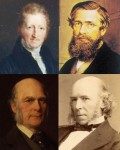Continued review of the history of the science relating to human biology, genetics and race.
More on Herbert Spencer and what Richard Hofstadter (and others concerned about the best interests of jews) retroactively identified and pathologized as Social Darwinism:
The name social Darwinism is a modern name given to the various theories of society that emerged in England and the United States in the 1870s, which, it is alleged, sought to apply biological concepts to sociology and politics.[1][2] The term social Darwinism gained widespread currency when used in 1944 to oppose these earlier concepts. Today, because of the negative connotations of the theory of social Darwinism, especially after the atrocities of the Second World War (including the Holocaust), few people would describe themselves as Social Darwinists and the term is generally seen as pejorative.[3]
Social Darwinism is generally understood to use the concepts of struggle for existence and survival of the fittest to justify social policies which make no distinction between those able to support themselves and those unable to support themselves. Many such views stress competition between individuals in laissez-faire capitalism; but the ideology has also motivated ideas of eugenics, scientific racism, imperialism,[4] fascism, Nazism and struggle between national or racial groups.[5][6]
Opponents of evolution theory have often maintained that social Darwinism is a logical entailment of a belief in evolutionary theory, while biologists and historians maintain that it is rather a perversion of Charles Darwin’s ideas
The argument that Nazi ideology was strongly influenced by social Darwinist ideas is often found in historical and social science literature.[40] For example, the Jewish philosopher and historian Hannah Arendt analysed the historical development from a politically indifferent scientific Darwinism via social Darwinist ethics to racist ideology.
The jews (and others concerned about the best interests of jews) didn’t directly attack “the concepts of struggle for existence and survival of the fittest” or “the ideas of struggle between national or racial groups” via science. Instead they imposed social and political taboos and sanctions.
William Bateson coined the term genetics in 1905, but the man regarded as the father of genetics is Friedrich Leopold August Weismann:
(17 January 1834 – 5 November 1914) was a German evolutionary biologist.[1] Ernst Mayr ranked him the second most notable evolutionary theorist of the 19th century, after Charles Darwin.
His main contribution was the germ plasm theory, according to which … inheritance only takes place by means of the germ cells—…such as egg cells and sperm cells. Other cells of the body—somatic cells—do not function as agents of heredity. The effect is one-way: germ cells produce somatic cells and are not affected by anything the somatic cells learn or therefore any ability the body acquires during its life. Genetic information cannot pass from soma to germ plasm and on to the next generation. This is referred to as the Weismann barrier.
Weismann was an opponent of Lamarckism, the inheritance of acquired characteristics, and was determined to discredit it:
Weismann conducted the experiment of removing the tails of 68 white mice, repeatedly over 5 generations, and reporting that no mice were born in consequence without a tail or even with a shorter tail.
In the conclusion of his description of this experiment, Essays upon heredity and kindred biological problems, published in 1889, Weismann writes:
the mutilations of certain parts of the human body, as practised by different nations from times immemorial, have, in not a single instance, led to the malformation or reduction of the parts in question. Such hereditary effects have been produced neither by circumcision, nor the removal of the front teeth, nor the boring of holes in the lips or nose, nor the extraordinary artificial crushing and crippling of the feet of Chinese women. No child among any of the nations referred to possesses the slightest trace of these mutilations when born : they have to be acquired anew in every generation.
In searching out Weismann’s original words on the matter I ran across the phrase “the jewish fondness for Lamarckism”. This turned out to be a fruitful lead to German geneticist Fritz Lenz. Lenz’s thoughts and work are described by Robert N. Proctor, Professor of History of Science at Stanford, in his book Racial Hygiene: Medicine Under the Nazis, published in 1988:
Lenz’s rejection of Lamarckian inheritance was part of the broader rejection by racial hygienists of any substantial role for the environment in shaping human behavior and social institutions. For Lenz, “environmentalism” could be upheld only on ideological, not scientific, grounds.
More on Lenz and racial hygiene next week.
The podcast will be broadcast and available for download on Tuesday at 9PM ET.
Podcast: Play in new window | Download











